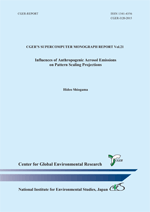SHIOGAMA H.
CGER Reports
CGER’S SUPERCOMPUTER MONOGRAGH REPORT Vol.21
Adapting to and mitigating human induced climate change are matters of immediate concern for the world. Coupled atmosphere-ocean general circulation models (AOGCMs) are primary tools to produce climate change scenarios under given future emission scenarios. Future developments of socioeconomic conditions are not fully predictable and in part depend on our decisions. Therefore it is essential to investigate the uncertainties of climate change scenarios (and impacts) under a wide range of socioeconomic/emission scenarios to inform mitigation and adaptation policies. However, the large costs of AOGCM prevent generating simulations for a wide range of emission scenarios. To overcome this limitation, the following method called “pattern scaling” was developed: (i) a climate change pattern per 1K global warming (scaling pattern) is made from the outputs of an AOGCM simulation under a given emission scenario; (ii) we compute projections of global mean temperature change for multiple emission scenarios using a simple climate model; (iii) we can obtain climate scenarios for a number of emission scenarios by multiplying the scaling pattern of (i) by the projections of global mean temperature change in (ii). Although this pattern scaling method has been widely used in impact, adaptation and mitigation studies, validations of this method have been limited, and further investigations are clearly warranted.
This monograph is based on three published papers (Shiogama et al. 2010a, 2010b, 2013). In chapters 1 and 2, the author tested a basic assumption of pattern scaling, namely the scaling pattern is common to different emission scenarios. Figure 1 shows the scatter plot of the changes in global mean temperature and precipitation in the Model for Interdisciplinary Research on Climate version 3 (MIROC3) AOGCM during the 21st century for two emission scenarios (termed A2 and B1), where greenhouse gas concentrations and aerosol emissions are larger in A2 than in B1. The slopes of the regression lines show the precipitation sensitivity per 1K global warming. The precipitation sensitivity of A2 is smaller than that of B1. The same dependency of precipitation sensitivity on emission scenario is found in multi AOGCMs (Figure 2). Different aerosol emissions cause this emission scenario dependency, leading to significant biases of water resource assessments using the pattern scaling method.


A useful approach to overcome the errors in the pattern scaling of precipitation is “separated scaling of greenhouse gases and aerosol responses”. A basic assumption of the separated scaling method is “linear additivity of climate forcing-response relationship”. The author investigated whether individual climate responses to individual forcing agents were linearly added in order to obtain the total climate response to the sum of the forcing agents in chapter 3. It was found that the linear additivity broke down for precipitation responses in some cases (Figure 3).

In this monograph, it is suggested that pattern scaling requires further investigations of applicability and techniques to reduce errors.
The present report is based on the following papers:
- Shiogama H., Emori S., Takahashi K., Nagashima T., Ogura T., Nozawa T., Takemura T. (2010a) Emission scenario dependency of precipitation on global warming in the MIROC3.2 model. J. Climate, 23 (9), 2404-2417.
- Shiogama H., Hanasaki N., Masutomi Y., Nagashima T., Ogura T., Takahashi K., Hijioka Y., Takemura T., Nozawa T., Emori S. (2010b) Emission scenario dependencies in climate change assessments of the hydrological cycle. Climatic Change, 99 (1/2), 321-329.
- Shiogama H, Dáithí A. Stone, Tatsuya Nagashima, Nozawa T. and Seita Emori (2013) On the linear additivity of climate forcing-response relationships at global and continental scales. International Journal of Climatology, 33 (11), 2542–2550.


